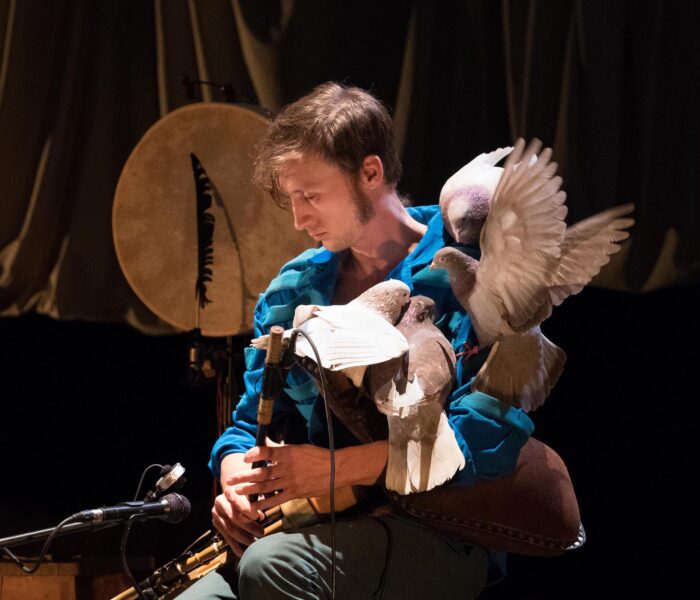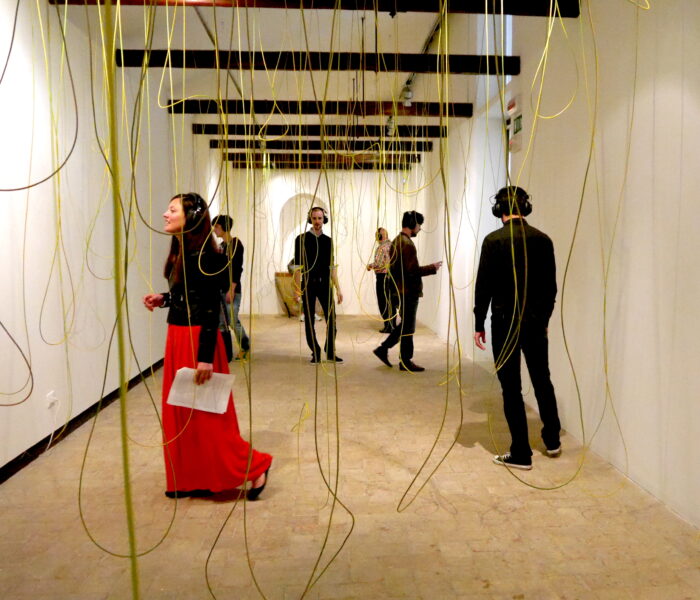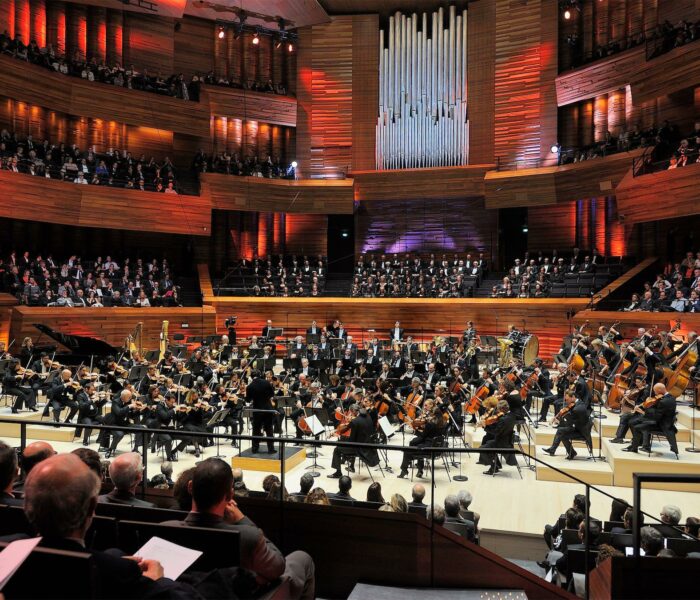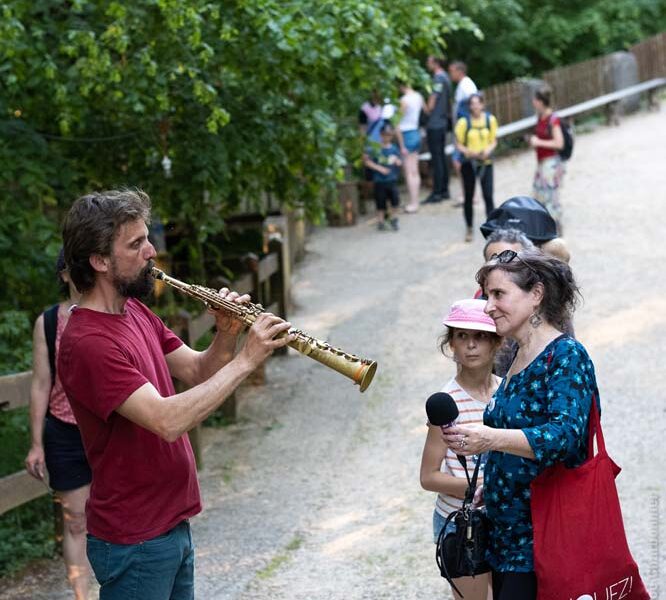À travers l’évolution des formes du concert se jouent aussi non seulement la prise en compte des nouvelles pratiques culturelles, mais aussi l’invention d’un nouveau rapport aux spectateurs. Un enjeu qui, au moins autant que les artistes, concerne les institutions culturelles.
L’émergence de l’immersion – ou le concert comme expérience « totale »
Parallèlement aux transformations que les artistes ont fait subir à la forme du concert, notamment depuis l’après-guerre, s’est opérée une profonde mutation des « pratiques culturelles » et des habitudes d’écoute, grandement corrélée à des évolutions technologiques (qu’il s’agisse de l’enregistrement de la musique ou de sa médiatisation) qui ont démultiplié les capacités de diffusion des œuvres et les manières de rencontrer celles-ci. Ces dernières années par exemple, la notion d’immersion semble bien s’être imposée comme la nouvelle tarte à la crème des institutions culturelles, et notamment musicales, soucieuses à la fois de capter les générations digiborigènes et de mettre à profit l’essor des technologies numériques. En 2019, une étude publiée par le CNC sous le titre « Réalité virtuelle et expériences immersives en France » révélait que, pour 93% des personnes interrogées, les expériences immersives constituaient « une nouvelle façon d’aborder la culture et les loisirs ». Un résultat qui s’est notamment soldé, en 2022, par le remplacement du DICRéAM (Dispositif pour la Création Artistique Multimédia et Numérique piloté par le CNC) par un « fonds d’aide à la création immersive » qui a fait grincer bien des dents, semblant imposer l’immersion comme le nouveau sésame de l’émergence artistique.
Plus généralement, il s’agit de plus en plus de faire du concert une véritable « expérience », convoquant tous les sens du spectateur – après l’« œuvre d’art total » chère à Wagner, arriverait-on à l’« expérience artistique totale » ? On pourrait se limiter cyniquement à pointer l’inéluctable arraisonnement de la notion d’expérience par la sphère du marketing (« expérience client, « expérience voyageur », » expérience visiteur ») dans un contexte généralisé d’« instagramisation » du monde. On pourrait également rappeler que, comme l’ont montré par exemple les travaux de Jacques Rancière(1), la position de spectateur assis n’est pas forcément synonyme de passivité. On pourrait enfin choisir de se boucher le nez en déclarant que la musique est une affaire trop sérieuse pour transformer les salles de concert en parcs de loisirs.
Mais on peut également choisir de s’en réjouir, et voir dans les dispositifs immersifs l’une des manières, pour la musique « classique » en général, et pour la musique contemporaine en particulier (même si celle-ci est moins confrontée que celle-là au phénomène de vieillissement de son public), de renouveler son audience, et d’attirer des personnes d’ordinaire peu enclines à pousser les portes des salles de concert. Des multiples aventures offertes par l’Espace de projection de l’Ircam dans le domaine de la 3D sonore(2) aux œuvres-fleuves d’un François Sarhan (Éphémère enchainé, 2015) ou d’un Alexander Schubert (Asterism, 2021) ; des relectures sous casque des Suites de Bach récemment imaginées par la violoncelliste Soizic Lebrat (Bach to 3D, 2023) à la nouvelle production de l’opéra Einstein On The Beach de Philip Glass par Susanne Kennedy et Markus Selg que l’on pourra voir dans le cadre du prochain Festival d’Automne à Paris, de plus en plus nombreuses sont les propositions artistiques qui témoignent d’une volonté de complexifier l’expérience de l’écoute. Souvent, il s’agit, comme on l’a dit, de convoquer tous les sens du spectateur, jusqu’à amener celui-ci dans un état proche de la transe qui renouerait peut-être avec les pratiques les plus archaïques (voir le retour en grâce dont jouit actuellement le terme de « chamanisme » dans les programmes de salles et les discours des artistes) ; de faire perdre à celui-ci ses repères, à tout le moins de lui en proposer d’autres que celui de la confrontation frontale à l’œuvre et ses interprètes.
La frontalité n’est pas une fatalité
Car après tout, ainsi que je le rappelais dans une précédente chronique sur ce même site, la forme du concert public « n’a que deux siècles, et il a fallu l’apparition de la version romantique de l’artiste (puis l’invention de l’électricité, qui rend possible de faire le noir dans la salle), le triomphe vers 1820 de ce goût allemand pour l’écoute attentive qui donne la prééminence à la fonction esthétique de la musique, pour que la forme frontale et silencieuse de ce jeu entre un interprète, un auditeur et une œuvre se ritualise à son tour. » Il a par exemple fallu attendre 1945 pour que l’on cesse d’applaudir entre les mouvements d’une œuvre(3) – une pratique devenue aujourd’hui excessivement clivante, par laquelle le bon grain des mélomanes se distingue – au sens bourdieusien du terme – de l’ivraie des néophytes. Aujourd’hui, force est de reconnaître que ces rituels d’un autre âge doivent être réinventés si la « grande » musique, et les musiques de création dans leur ensemble, veulent conquérir un nouveau public – et que bon an mal an, de plus en plus d’institutions musicales s’y emploient. Qu’il s’agisse de la frontalité ou de la manière de présenter un programme, qu’il s’agisse de la durée de celui-ci ou de la façon excessivement codifiée dont les interprètes se présentent, il y a encore beaucoup de paramètres sur lesquels jouer pour qu’un concert puisse opérer pleinement son effet sur les spectateurs de 2023 – même si avec certains de ses paramètres, tels que le silence de l’écoute, il me semble certes difficile de transiger.
En tant que spectateur, j’avais été profondément marqué, par exemple, par un concert de l’ensemble ]h[iatus en trio auquel j’avais assisté en 2007 au festival Sonorités à Montpellier, enchaînant des pièces de James Tenney, Helmuth Lachenmann ou Salvatore Sciarrino sans interruption, si ce n’est des improvisations des musiciens qui permettaient de passer de l’une à l’autre. Rarement autant que lors de cette soirée – sur laquelle je revenais en 2021 dans une autre chronique, « Du récital à la playlist » – j’avais écouté un concert de musique contemporaine avec une attention aussi soutenue, aussi présente.
En tant que programmateur, je me suis ainsi modestement employé, autant que faire ce pouvait, à proposer d’autres formats de concert, d’autres manières de présenter celui-ci : que ce soit en insistant auprès des musiciens sur l’importance de communiquer avec le public ou en jouant sur la durée de l’événement, soit via des programmes-fleuves, soit en programmant des œuvres aux proportions inhabituelles, telles que les cycles November de Dennis Johnson (1959) ou Inner Cities d’Alvin Curran (1996-2010) – un compositeur qui n’a eu de cesse d’inventer des alternatives au concert traditionnel. Il est vrai que les musiques affiliées au minimalisme présentent un terrain de jeu singulièrement fertile pour imaginer d’autres conditions d’écoute et d’autres expériences de la musique live – que l’on songe aux compositions-fleuves d’un La Monte Young ou aux « All-Night Concerts » que donnait jadis Terry Riley.
Que l’écoute soit déambulatoire ou au contraire statique, intermittente ou constante, il s’agit dans tous les cas, me semble-t-il, de confier à l’auditeur un rôle actif, de stimuler son attention, de l’impliquer plus étroitement à ce qui est en train de se jouer.
Petit éloge de la participation
La création, fin 2020, d’une « Délégation générale à la transmission, aux territoires, et à la démocratie culturelle » au sein du ministère de la Culture montre bien la prise en compte de l’urgence à travailler sur ces questions (et du retard pris en la matière). Il était temps, en vérité, de prendre acte de l’échec de ce que l’on a appelé la « démocratisation culturelle », et surtout des avancées ouvertes en 2007 par la Déclaration de Fribourg sur les droits culturels. En insistant sur la nature fondamentalement diverse (et non univoque) de la notion de « culture », ce texte souligne combien cette dernière est la condition première de l’émancipation, et à ce titre le ferment de la démocratie et de la citoyenneté.
L’un des grands mérites de la Déclaration de Fribourg est de substituer la notion de « personnes » à celle de public. Substitution infiniment féconde si l’on prend la peine de réfléchir à tout ce qu’elle implique, pour les institutions culturelles, dans la manière de s’ouvrir à d’autres expressions culturelles et de s’adresser aux personnes qu’elles accueillent. L’essor des concerts participatifs semble à ce titre proposer l’une des évolutions les plus significatives de ces dernières années.
Bien entendu, il y a participation et participation : celle-ci n’est pas une garantie de réussite en soi, car de nombreux critères entrent en ligne de compte dans le succès de telles actions – à commencer par la manière de s’adresser aux personnes concernées, qu’il s’agisse des artistes ou des participant.e.s(4). Et il ne faudrait pas qu’au motif qu’elle permette de « cocher un grand nombre de cases » dans les dossiers de subvention, la participation ne vienne rejoindre l’immersion au nombre des tartes à la crème institutionnelles contemporaines. Elle semble être toutefois une forme particulièrement intéressante de renouvellement des formes, permettant aux artistes professionnels de faire évoluer leur pratique et leur manière de considérer leur discipline et de la présenter aux « spect-acteurs » – de mettre à bas, en somme, le « quatrième mur » du son.
David Sanson
1. Voir notamment Le Spectateur émancipé, Paris, La Fabrique, 2009.
2. Voir l’article « 1977-2023 : l’odyssée de l’Espace de projection » récemment publié dans le numéro 23 de L’Étincelle, « le journal de la création à l’Ircam », pp. 26-36.
Retrouver sur Metaclassique, partenaire d’Hémisphère son, l’émission Voter autour de Music of Choices d’Alexandros Markéas :



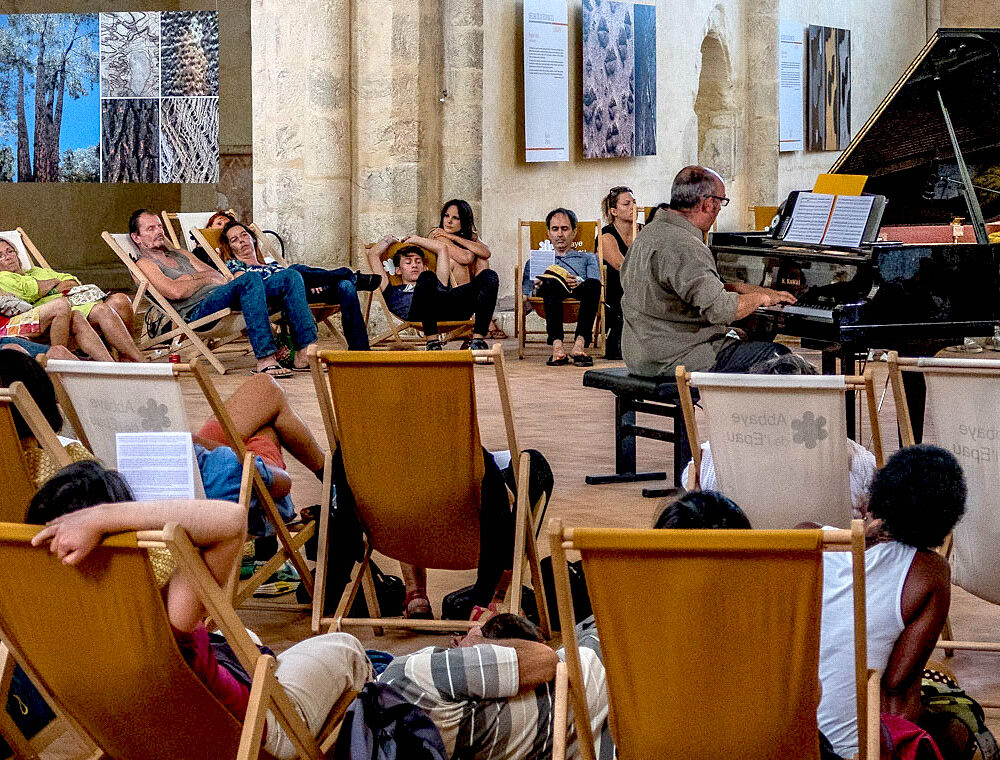)
